Advanced Molecular Chemistry
- Professor: MIYAMOTO Kazunori
- Associate Professor: HIGASHIBAYASHI Shuhei
- Senior Assistant Professor: HANAYA Kengo
Chemical and pharmaceutical research utilizing the power of the elements
In Advanced Molecular Chemistry Lab, we conduct research on a wide range of topics, from basic to applied sciences including the basic principles of elements, bonds, molecules, and the chemical reactions. We also focus on the synthetic organic chemistry for the production of novel chemical spaces of biologically active molecules such as medicines, multi-functionalized materials, and unexplored reactive intermediates with good methods. New reactions and methodologies are essential for the synthesis of uncharted molecular skeletons and functional groups, which greatly expand 21st century sciences. Therefore, we consider it extremely important to understand "why" and "how" reactions and phenomena occur at the molecular level and unveiling them is an important research object. We are also engaged in research to discover new concepts through the relationship between previously unused "energy sources", "molecules", and thereby create original methodologies.
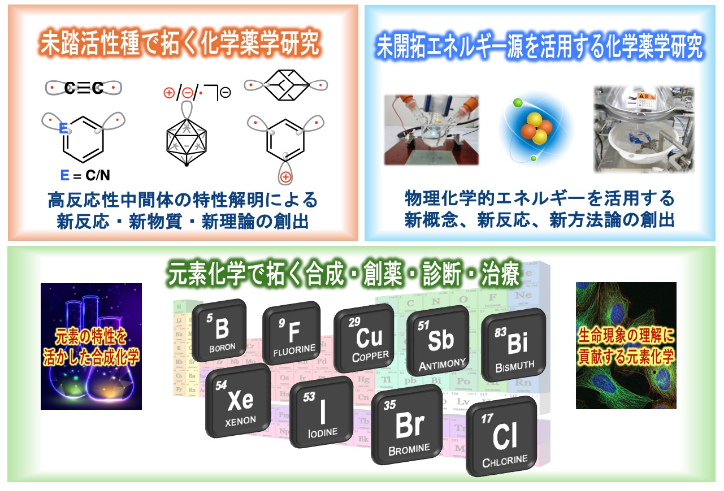
In medicinal chemistry, it is important not only to develop new reactions and reagents, but also to understand the function of biomolecules such as enzymes and receptors that receive the substances in order to create the medicines. Therefore, we are actively engaged in research that contributes to the understanding of life phenomena and medicine through the development of new synthetic and modification methods for biofunctional molecules that help to elucidate their functions.
The major goal common to all the above research is to gain a deep understanding of the properties of 'molecules', clarify the mechanism of the 'reactions' governed by them, and utilize them to pioneer new chemistry.
Natural Medicines
- Professor: KIKUCHI Haruhisa
- Assistant Professor: NISHIMURA Takehiro
Exploitation of New Natural Resources for Drug Discovery
Outline
Humans have been using plants, mushrooms, and other organisms as medicines since ancient times. In fact, many medicines have been developed from natural compounds produced by plants, fungi, bacteria, and other microorganisms. Thus, natural compounds are the resources for drug discovery.
We conduct research to find natural product that can be used as resources for drug discovery, or to create them using natural compounds as motifs. In addition, we aim to use the substances obtained as seed compounds for the development of pharmaceuticals, as well as for the development of substances useful for life science research.
On the other hand, as a result of the vigorous search for natural compounds, new natural compounds are being depleted. Therefore, it is not possible to conduct innovative drug discovery research by simply searching for natural compounds in the conventional way. Therefore, we will actively explore new resources for drug discovery.
- 1.Exploitation of new resources for drug discovery using diversity-oriented synthesis
-
Diversity-oriented synthesis is a synthetic method for producing a large number of compounds with different molecular skeletons from a single starting material. In particular, "diversity-enhanced extracts," which combine diversity-oriented synthesis with search for natural compounds, can yield a group of new compounds with structural diversity that exceeds that of natural compounds obtained from plants and microorganisms. We will conduct research to utilize these compounds as resources for drug discovery.
For example, we will perform chemical reactions directly on the extracts of medicinal plants used as crude drugs, as used in diversity-directed synthesis, to produce diversity-enhanced extracts. By separating, purifying, and structurally determining these extracts, we can construct a library of structurally diverse compounds and obtain seed compounds for drug discovery research. - 2.Development of new resources for drug discovery using unexploited organisms
-
As a new drug discovery resource, we will focus on " unexploited organisms" which are different from conventionally used organisms, such as plants, fungi, and bacteria, for the search of natural compounds. Particularly, we will focus on protists, which are extremely diverse organisms that span multiple biological kingdoms, and utilize unexploited organisms such as cellular slime mold, oomycetes, and pelagic algae. In fact, compounds obtained from cellular slime mold have been developed as commercially available reagents for life science research. Thus, these unexploited organisms, including cellular slime mold, are considered to have great potential as new resources for drug discovery.
- 3.Molecular Networking Construction and Dereplication in Multi-component Systems
-
Extracts of plants and microorganisms are multicomponent systems containing various compounds, and it is not easy to obtain structural information and quantities of all the compounds contained. We have developed molecular networking based on compound data obtained by simultaneous multi-component analysis using LC-MS/MS, which enables visual understanding of compound profiles in multi-component systems. In addition, by efficiently eliminating known compounds (dereplication), we are able to rapidly discover new compounds and estimate their structures. By applying this analytical platform, for example, we are searching for new compounds produced by cyanobacteria, determining the quality of crude drugs, and analyzing compound-compound interactions in multicomponent systems.
Molecular Design
- Professor: KUMAGAI Naoya
- Assistant Professor: TSUTSUMI Ryosuke
- Assistant Professor: KOBAYASHI Toi
- Project Assistant Professor: IWAI Atsushi
Design, Synthesis, and Application of Novel Functional Heterocyclic Compounds
DATB (1,3-Dioxa-5-Aza-2,4,6-TriBorinane), a peculiar six-membered heterocyclic entity without any carbon atoms designed by our group, strongly catalyzes amide bond-forming reactions from carboxylic acids and amines. In contrast to reagent-driven amidation reactions that produce reagent-derived waste, water is the sole by-product in the environmentally sustainable DATB catalysis, which will find its utility in the large-scale production of amide-containing therapeutics. DATB is a thermally stable solid and is now commercially available on a world-wide basis. We aim to further explore DATB catalysis and design/development of novel heterocyclic entities for as-yet unknown molecular functions.
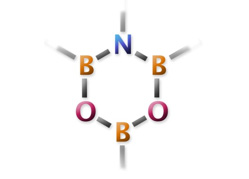
Design, Synthesis, and Application of Concatenated Azoles with iconic Structures
TriQuinoline (TQ) is a head-to-tail quinoline trimer with a pseudo-planar architecture, bearing a one-atomic size defect at the very center of the molecule. TQ strongly holds a proton at the defect to be a charged species, acquiring water-solubility despite its expected lipophilicity. TQ forms supramolecular complexes with other aromatic compounds via both π-π(face to face)and CH-π(edge to face)interactions, allowing for inhibitory effects on cancer cell proliferation and modulation of lipid-lipid phase separation in live cells. The flexible derivatization capability of TQ will be leveraged to identify a new class of functional and bioactive azole-type molecules. Current works are focused on the design and synthesis of a larger three-dimensional architecture to expand the potential of these azole-based molecular entities.
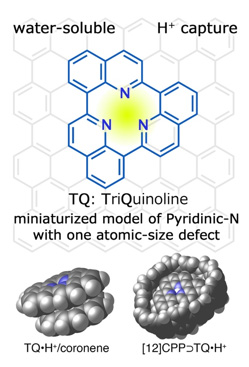
C4N4 Fluorophore
We have identified a new class of fluorescent molecules named C4N4 with a diaminopyrimidine core composed of four carbon and nitrogen atoms. C4N4 fluorescent molecules can be synthesized from commercially available chemicals in a modular fashion, producing strongly luminescent molecules with a large Stokes shift and a solid state emission capability applicable to live-cell bioimaging. We are currently pursuing strategic structural modifications to develop a more sophisticated fluorescent host composed of C4N4 units able to sense specific guest molecules for application as novel CPL molecules.
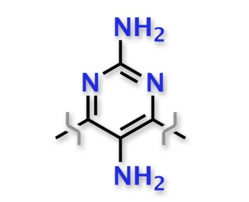
Hygienic Chemistry
Investigation of the molecular basis for prevention of lifestyle-related diseases through the food
Prevention of lifestyle-related diseases such as obesity, hyperlipidemia, arteriosclerosis, diabetes, and hypertension is a urgent issue for the public health of our nation. Aiming at the prevention of lifestyle-related diseases through diet, we are carried out to research from various angles.
- Prevention of lifestyle-related diseases through effects of foods on the metabolism of steroids.
Steroid hormones such as estrogens and glucocorticoids, have a variety of physiological activity, and their activities are known to correlate with the risk of developing a variety of lifestyle-related diseases. On the other hand, it has been well recognized that diet has a significant impact on prevention and risk of developing lifestyle-related diseases. There are various reports which show correlation between the effects on prevention of lifestyle-related diseases and the effects on steroid metabolism by food ingredients. In recent years, epidemiological studies showed that coffee has preventive effect against a variety of lifestyle-related diseases, including cancer and diabetes. Then, we are evaluating the effect of coffee on the steroid hormone metabolism. - Analysis of the molecular basis of the effects of probiotics on the lifestyle-related diseases.
Epidemiological studies indicate that there is a habitual intake effect of bifidobacteria and lactobacteria contained in yogurt to prevent lifestyle-related diseases, such as cancer and hyperlipidemia and inflammatory gastrointestinal disease. Using cultured cells derived from human gastrointestinal tract, we have analyzed the effects of probiotics on the immune system and cholesterol absorption within the digestive tracts.
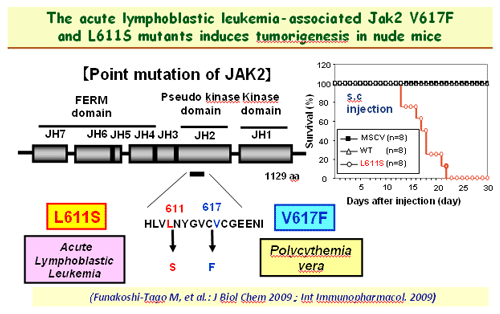
Biochemistry
- Professor: HASE Koji
- Senior Assistant Professor: TAKAHASHI Daisuke
- Assistant Professor: SUZUKI Koichiro
- Project Assistant Professor: OGUCHI Hiroyuki
Humans harbor over 100 trillion bacteria in the distal intestine. These commensal bacteria have long been appreciated for the benefits they provide to the host, the most obvious being their capacity to metabolize indigestible food components to small metabolites that are utilized as nutrients by host cells. Moreover, it is now clear that the presence of commensal bacteria contributes to shape the gut immune system though promoting the development of gut-associated lymphoid tissues (GALTs), the largest collection of secondary lymphoid organs, which are necessary for induction of mucosal IgA responses. To evoke the mucosal immune response, antigens on the mucosal surface must be transported across the epithelial barrier into GALT such as Peyer's patches. This function, called 'antigen transcytosis', is mediated by specialized epithelial M cells. We are currently conducting the studies to understand the molecular machinery by which intestinal M cells facilitate antigen transcytosis.
Certain enteric bacteria also facilitate differentiation of Th17 and Treg cells, both of which are major T cell populations in the intestinal mucosa. Thus, host-microbe interactions establish immunological homeostasis in the gut, which further raises the important question: how do commensal bacteria affect the host immune system? The intestinal microbiota constitutes a considerable bioreactor that ferments indigestible food substances (e.g., soluble dietary fibers and resistant starches) into various metabolites such as short-chain fatty acids (SCFAs). Notably, butyrate, a major SCFA, exert histone deacetylase (HDAC) inhibitory activity. We have shown that intestinal microbiota-derived butyrate contributes to establishing intestinal symbiosis by inducing Treg cells via the epigenetic mechanisms. Our laboratory aims to explore the epigenetic regulation of the immune system by intestinal microbiota, and also to elucidate the biological significance of this epigenetic regulation in immunity and metabolism.
Key publications:
Kimura I. et al., Science 367: eaaw8429, 2020.
Nagai M. et al., Cell 178: 1072-1087, 2019.
Furusawa Y. et al., Nature 504: 446-450, 2013.
Physics for Life Functions
- Professor: OSAWA Masanori
- Senior Assistant Professor: YOKOGAWA Mariko
- Assistant Professor: ISHIDA Hanako
Our research objectives are: (1) to reveal structural mechanisms of proteins critical for life functions at atomic level, (2) to establish novel strategies for drug developments based on the mechanisms, and (3) to create compounds to regulate the life functions. Proteins playing important roles physiological processes are analyzed at an atomic resolution by nuclear magnetic resonance (NMR) spectroscopy and X-ray crystallography.
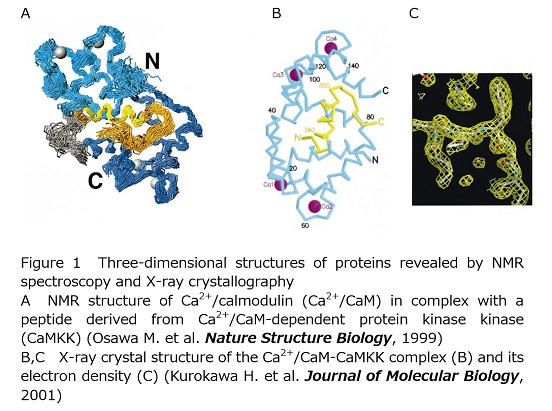
Pharmacology
The major focus of this laboratory is a disease-oriented basic neuroscience research. Although recent progress in the neuroscience field begins to shed light on complicated interactions between genetic and epi-genetic (environmental) control in the nervous system, fundamental brain functions such as learning/memory, attention, sleep, movement control are largely still enigmatic.
Neurodegenerative diseases are adult-onset and slowly progressive disorders affecting the central and peripheral nervous system. One of the major causes of the diseases is known to be aging. With the growth of elderly population, risks of suffering from these diseases are rapidly increasing and making them heavy social burden.
The main goals of our research are to elucidate physiological and pathological roles of cholinergic neurons in neurologic/psychiatric diseases such as Alzheimer's, Parkinson's, amyotrophic lateral sclerosis (ALS) and schizophrenia, and ultimately develop better pharmacological interventions to these devastating conditions.
We are looking forward to working with motivated students who have high interest in basic research for uncovering hidden mysteries of brain functions and their disorders.
Physiological Chemistry and Metabolism
- Professor: ARITA Makoto
- Senior Assistant Professor: OHBA Yohsuke
- Assistant Professor: MOROZUMI Satoshi
Molecular Oncological Pharmacy
- Professor: SHIBATA Atsushi
DNA repair research for cancer therapy
Our laboratory aims to elucidate the molecular mechanism underlying DNA double-strand break (DSB) repair, which is critical for maintaining genome integrity. Defects in DSB repair lead to severe mutations, including deletions and chromosomal translocations, which cause cell death. Introducing such severe mutations is important for killing cancer cells via radio/chemotherapy. In addition, DSB repair and signaling is involved in many biological events such as tumorigenesis, immunity, protection against virus, and biological development. We have recently attempted to visualize a repair event at a single DSB using super-resolution microscope 3D structured-illumination microscopy (SIM) in combination with next generation sequence techniques such as ChIP-seq and ATAC-seq.
Our final goal is to contribute to the development and improvement of cancer therapy by exploiting the knowledge of DNA repair research. We are currently focusing on the immune responses after DNA damage induction during cancer treatment.
Representative publications:
DSB repair pathway choice
Transcription associated DSB repair in G1 Yasuhara et al., Cell Rep, 2022
HR initiation at transcription active loci Yasuhara et al., Cell, 2018
DSB repair pathway choice in G1 Biehs et al., Mol Cell, 2017
53BP1 dephosphorylation promotes pro-HR environment Isono et al., Cell Rep, 2017
MRE11-dependent initiation of resection Shibata et al., Mol Cell, 2014
DSB repair pathway choice in G2 Shibata et al., EMBO J, 2011
DDR dependent immune ligands regulation
DNA damage promotes HLA class I presentation Uchihara et al., Mol Cell, 2022
BER deficiency upregulates PD-L1 expression Permata et al., Oncogene, 2019
DSB-dependent ATR/Chk1 upregulates PD-L1 expression Sato et al., Nat Comm, 2017
Analytical Chemistry for Drug Discovery
- Professor: HANAOKA Kenjiro
- Senior Assistant Professor: SASAKI Eita
- Assistant Professor: YAMADA Sota
- Project Assistant Professor: OHNO Hisashi
- Project Assistant Professor: TAKAYAMA Orie
In the analysis of biological phenomena and pathology, "smart molecules" having special functions enable the visualization and control of biological phenomena, which have never been achieved by conventional methods. These molecules exhibit various abilities in biological samples by precisely designing the molecular structures. The objective of our laboratory is to develop new functional molecules which can be applicable in pharmaceutical research. We design and synthesize these functional molecules, and apply them to molecular imaging, drug discovery, drug delivery system (DDS), bio-separation and bio-analysis.
Activatable Fluorescent Probes Based on Novel Fluorophores:
We precisely designed and chemically synthesized activatable fluorescent probes, which can show the fluorescent spectral change in response to the specific biomolecules, based on our novel fluorophores (Angew. Chem. Int. Ed. 2020, 59, 6015. J. Am. Chem. Soc. 2018, 140, 5925. J. Am. Chem. Soc. 2017, 139, 13713, etc.). By using these probes, the dynamics of biomolecules in biological systems can be visualized. Our goal is to apply these probes to the fluorescence imaging of biosamples and realize the biological phenomena.
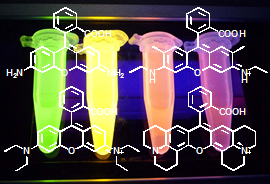
Self-assembling Designer Proteins:
We genetically and chemically engineer self-assembling proteins to create designer protein shells which serve as molecular containers for storage, delivery and production of bioactive materials (Nat. Commun. 2017, 8, 14663. ChemBioChem 2020, 21, 74-79.). Our goal is to apply such functional protein shells to drug delivery systems and molecular sensors to analyze and control various biological phenomena.
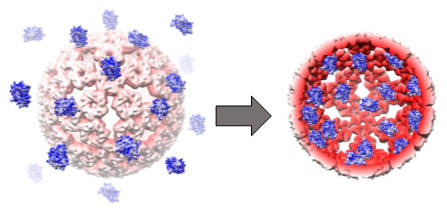
Purification of Biopharmaceutical and Cells using Functional Polymer:
We are developing innovative purification system for biopharmaceuticals and therapeutic cells using functional polymers. The system can purify antibody drugs and stem cells with maintaining their activity and low cost (Anal Chim Acta. 2020, 1095, 1. Biomater. Sci. 2021, 9, 663.). Thus, the developed purification system would reduce pharmaceutical prices and improve therapeutic efficacy in cell transplantation therapy.
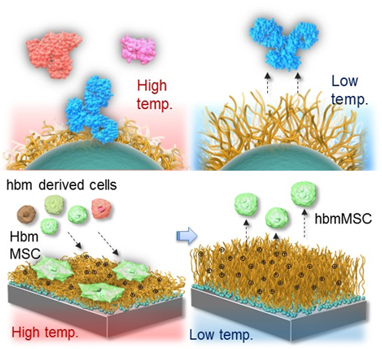
Pharmaceutics
- Professor: TOMI Masatoshi
- Assistant Professor: NOGUCHI Saki
- Assistant Professor: TSUCHITANI Toshiaki
Pharmaceutics is a discipline to pursue the optimal delivery of drug substance to target site of patient's body through the best scientific knowledge and technology, so that patients are released from diseases and disorders. The ultimate goal of our research is "Individualized Pharmaceutical Care".
For realizing such an object, two projects are currently carried out ;
- Molecular mechanisms of drug transport across the blood-placental barrier
The transport process across the blood-placental barrier is a key determinant of fetal drug disposition. The elucidation of placental transport mechanism will provide molecular basis for the individual optimization of drug administration to expectant mothers in more-successful and strategic manner. The blood-placental barrier is formed by syncytiotrophoblasts. Conditionally immortalized syncytiotrophoblast cell lines, TR-TBTs were established in our laboratory. We have elucidated mechanisms of placental transport of several drugs, such as zidovudine and didanosine. These nucleoside analog reverse transcriptase inhibitors (NRTIs) are used for preventing the transmission of HIV from infected pregnant mothers to their fetuses. - Development of various tools for best utilization of drug information, especially, those of OTC therapy. We have developed a manual and an e-learning system of OTC (Over-the-Counter) medicines. These products are now available to public and are used at community pharmacies for guidance to patients.
Students to be welcomed are those who have interest in pharmaceutics and its clinical application. During the stay at our laboratory, students will acquire a vast knowledge of pharmaceutics and its meaningfulness for better clinical drug use. Through collaboration with other research units, students will have the opportunity to brush up their skills of international communication.
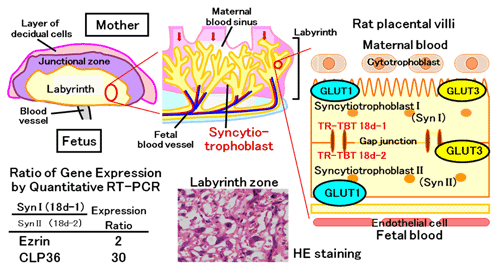
Clinical Physiology and Therapeutics
- Professor: MATSUSHITA Maiko
- Assistant Professor: SEKI Natsumi
Development of Novel Immunotherapy for Refractory Cancers
In recent years, there has been increasing attention on the ability of immune checkpoint inhibitors to activate immune cells against cancer cells. However, there are still some patients who cannot be cured with these drugs.
Our laboratory focuses on developing effective immunotherapies for cancers that are resistant to immune checkpoint inhibitors, such as pancreatic cancer, castration-resistant prostate cancer, and multiple myeloma. Specifically, we are conducting preclinical research aimed at elucidating the molecular mechanisms and applying them to therapy, focusing on immunogenic cell death (ICD), where cancer cells are effectively recognized by immune cells while undergoing cell death when certain drugs are added. Moreover, we are developing genetically modified T cell therapies, also known as "living drugs," using T cell receptor genes specific to antigens highly expressed in cancer cells.
These studies are conducted through translational research, where the results of basic research are applied to clinical practice, and reverse translational research, where questions arising from clinical practice are addressed through basic research.
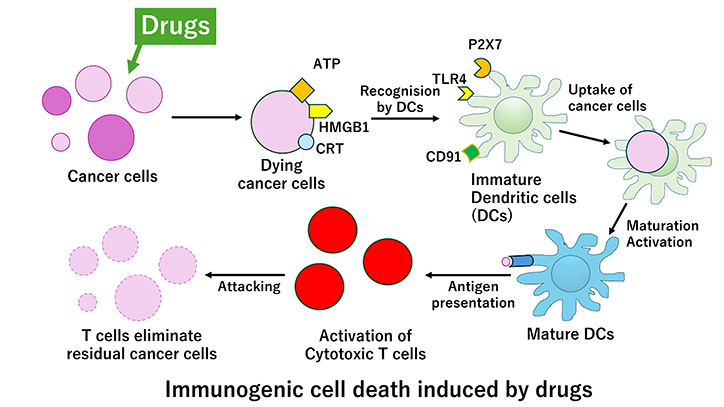
Pharmacotherapeutics
- Professor: SAITO Yoshimasa
- Senior Assistant Professor: KIMURA Masaki
- Assistant Professor: ISHIKAWA Takaaki
Our research targets are mainly on metabolic diseases necessary for keeping our homeostasis, especially on the diseases of gastroenterology, liver, muscle, adipose tissues and also cancers. Recently, we focus on epigenetics and microRNAs in the understanding of mechanism in these diseases. Our goal is to develop new therapeutic strategies for these diseases and we always think about the bench-to-bed utility. Our laboratory is always open to everyone who has a high motivation to create a new concept of pharmacotherapeutics. If you have interested in our department, why not join us?
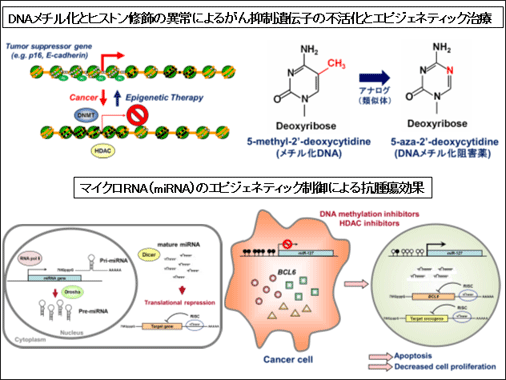
Clinical Pharmacy
- Professor: OHTANI Hisakazu
- Associate Professor: AKIYOSHI Takeshi
- Associate Professor: KAWAZOE Hitoshi
- Assistant Professor: IMAOKA Ayuko
- Assistant Professor: EZAKI Taketo
The educational target of our laboratory is to turn out researchers and pharmacists who have wide range of pharmaceutical view and knowledge, and is able to solve various clinical problems in pharmaceutical care. We consider that a good practitioner should be able to systematically organize a wide range of pharmaceutical knowledge and such ability can be acquired during pharmaceutical research.
Therefore, our research field is clinical pharmacy based on a variety of fields such as pharmacokinetics, pharmacodynamics, cell biology, information technology, and others. Especially, we aim to solve clinical problems, as mentioned below, for marketed drugs to create pharmaceutical evidences for proper and effective use of medicines.
- Study on drug metabolism and drug interactions to promote personalized pharmacotherapy.
- Quantitative prediction and IVIVE (in vitro-to-in vivo extrapolation) of drug interactions in drug absorption process.
- In vivo PK/PD study for dosage optimization to reduce adverse reactions.
- Optimization of pharmacotherapy by using the information technology and pharmacometrics
Drug Informatics
- Professor: HORI Satoko
- Associate Professor: IMAI Shungo
- Assistant Professor: KIZAKI Hayato
- Project Senior Assistant Professor: TSUCHIYA Masami
- Project Assistant Professor: YANAGISAWA Yuki
Drug information based on sciences and reliable clinical evidences is required for proper use of drugs. On the other hands, there is a tendency of "information overflow", even on a single drug, in different style, quality and quantity.
The objective of our laboratory is to explore the mean and way for rational and proper use of drug information so that medical professionals can give patients evidence-based, safe, and effective drug therapy. The areas of our research covered are information retrieval, critical appraisal, effective provision, and the application of information, etc.
Following research projects are currently ongoing;
- Methodology for the proper and effective provision of OTC drug information,
- Systematic reviews and network meta-analysis of pharmacotherapy and dietary supplements,
- Pharmacoecomics study, e.g., cost-effective analysis of switch OTCs and lifestyle-related diseases, comsumer's perception on payment, etc.
- Pharmacoepidemiology study, e.g., development of a reporting system of spontaneous adverse events by patients and consumers
- Pharmacogenetics/genomics of methotrexate and warfarin, etc.
Students joining to our research group are expected to acquire the research oriented way of thinking and proper insight on quality information of drugs. We expect that students will be able to play an active role in clinical fields, the pharmaceutical industry, and the government and the related organization after graduation.
Students to be welcomed are, such as, those with interest in proper and effective usage of drugs in clinical phase.
Pharmacodynamics
- Professor: MATSUMOTO Kazuaki
- Senior Assistant Professor: ENOKI Yuki
- Assistant Professor: IGARASHI Yuki
Establishment of New Pharmacotherapy Options Based on Drug Efficacy Evaluation and Adverse Event Analysis
The Division of Pharmacodynamics conducts research, aiming to establish new pharmacotherapy options by evaluating drug efficacy or the therapeutic and adverse effects of drugs.
To maximize their effectiveness while avoiding related adverse events as much as possible, the division analyses influencing factors, and clarifies optimal drug options and administration methods for each patient.
It also establishes new treatment methods by identifying new drug activities and developing new dosage forms. Furthermore, with a view to obtaining evidence that is useful for medical services, it identifies issues to be addressed (such as drug-drug interactions), and expands clinical and basic research.
The division aims to nurture clinical pharmacists to truly contribute to medical services and researchers with the ability to develop drugs needed in such services through research activities.
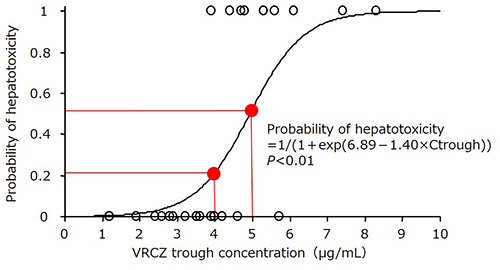
Figure. Voriconazole (VRCZ) trough concentration and logistic regression model for hepatotoxicity.
The estimated probability of hepatotoxicity at VRCZ trough concentrations of 2mg/L and 4mg/L was 1.6% and 21.6%, respectively
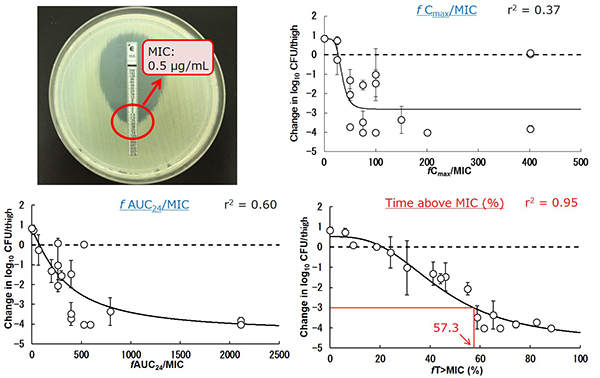
Figure. Relationships for Acinetobacter baumannii ATCC 19606 between the log10CFU/thigh at 24 h and the pharmacokinetic/pharmacodynamic indices.
Sulbactam showed time-dependent bactericidal activity, and was sufficiently bactericidal when an fT>MIC of >60% against A. baumannii thigh infection was achieved.
Drug Development and Regulatory Science
- Professor: URUSHIHARA Hisashi
- Assistant Professor: OKADA Yusuke
Every pharmaceutical product is subject to be registered and regulated under appropriate legislation because of its possible serious effects on human lives.
Then, question becomes what kind of data is required, why and when. How to collect such data and how to adequately evaluate are also essential factors to be clarified before starting of drug development process or, even whole life span of a drug.
Establishment of adequate and safe use of the drug in our real world is also crucial point to meet the expectation of patients and medical professions.
All the above issues consist of regulatory sciences and this laboratory is concentrating in clarifying and responding on these questions in accordance with scientific approach and international manner.
Our goal is not easy to be met particularly in the days of such a rapid progress in the human life science can be seen but therefore it is absolutely needed for regulatory sciences to catch up with it.
Students here will be exposed and gain such sciences through study and learning.
Integrative Clinical Pharmacology
Advancing the evidence for optimal biopharmaceutical treatment through real-world data analysis and innovative analytical technologies
Outline
Our Lab carries out real-world data analysis and pharmacokinetic research of biopharmaceuticals, including antibody drugs. A key aspect of our work is utilizing patient specimens and clinical information. We also collaborate with other research institutes and companies to develop innovative analytical methods for biopharmaceuticals using state-of-the-art technologies.
Examples of research themes
- Basic research on the pharmacokinetics of biopharmaceuticals using novel analytical methods.
- Clinical pharmacology research to advance personalized medicine for antibody drugs, utilizing real-world data.
- Clinical epidemiological research to facilitate the practical application of therapeutic drug monitoring (TDM) for antibody drugs.
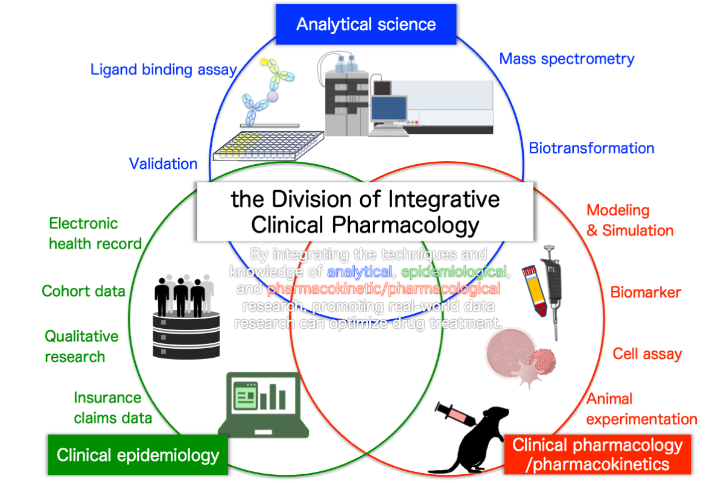
Healthcare Innovation in Pharmacy
- Director: ARITA Makoto
- Professor: MISAWA Hidemi
- Professor: HORI Satoko
- Assosiate Professor: FURUGEN Ayako
- Project Assistant Professor: YAMAGAMI Akira
Research purpose
As the aging population of Japan becomes a serious problem, it is important to promote prevention, self-care, and self-medication. The Division of Healthcare Innovation in Pharmacy was established in April 2024 through a donation from Sato Pharmaceutical Co., Ltd. The laboratory focuses on the following research topics:
- Scientific and social approaches to solving problems related to self-care and self-medication, including over-the-counter (OTC) drugs.
- Building innovative healthcare solutions from the perspective of residents.
- Education and consumer enlightenment toward achieving the above topics.
- Dissemination of information and publications to improve literacy on the use of OTC products.
Example of research themes
- Research on appropriate self-care and self-medication for special populations such as those with renal and hepatic impairment, lactating, pregnant, the elderly, and pediatric patients.
- Measuring and searching for biomarkers related to health maintenance.
- Investigation of adverse effects and drug-drug interactions and research on their mechanisms.
- Questionnaire surveys using consumer or patient panels.
- Research using medical big data and personal health records.
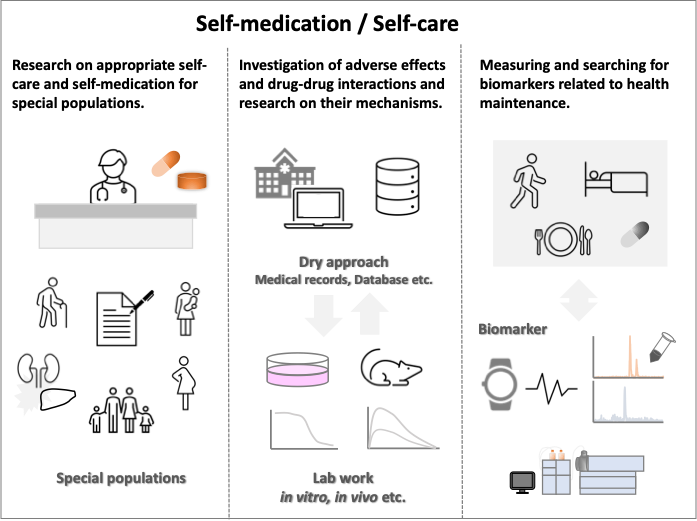
Center for Social Pharmacy and Pharmaceutical Care Sciences
- Director: NAKAMURA Tomonori
Division of Pharmaceutical Care Sciences
- Professor: NAKAMURA Tomonori
- Professor: SUZUKI Sayo
- Senior Assistant Professor: YOKOYAMA Yuta
- Assistant Professor: JIBIKI Aya
- Assistant Professor: NONOMIYA Yuma
Division of Social Pharmacy
- Professor: YAMAURA Katsunori
- Senior Assistant Professor: KOBAYASHI Noriko
- Senior Assistant Professor: IWATA Hiroki
- Assistant Professor: KONDO Shingo
- Assistant Professor: OKAMOTO Yuko
In 2001, Center for Pharmacy Practice was established with the purpose of excellence in medical pharmacy education and nurturing pharmacists who can contribute to the medical front. The early exposure program in a hospital and a community pharmacy run shortly after admission, the four-week practical training in a hospital and the two-week in a pharmacy were made compulsory ahead of other universities. These practical programs have made contribution to improving the motivation pharmacy students should have and keeping it up. The center also plays a central role in the "6-year education program in pharmacy" launched in 2006 with cooperating with many other medical facilities. In addition to enriching the early on-site training, the early pharmacy practical training in the second year focusing on dispensing, the lectures preparing for following practical training in the fourth year, and hands-on clinical session at full scale of hospitals and pharmacies for 11 weeks each are smoothly offered in Center for Pharmacy Practice.
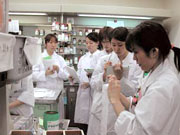
Education Research Center for Pharmaceutical Sciences
- Associate Professor: OHE Tomoyuki
- Professor: ISHIKAWA Satoko
- Associate Professor: AIZU-YOKOTA Eriko
- Senior Assistant Professor: MORIWAKI Yasuhiro
- Senior Assistant Professor: ICHIKAWA Daijyu
The responsibility of our group is to give undergraduate students the training of fundamental chemistry or biology for pharmaceuticals and pharmacy, such as analytical chemistry, pharmacology, biochemistry, hygiene chemistry and organic chemistry, so that students in Faculty of Pharmacy can have the ability to comprehend the modern and progressing life sciences. We are also responsible for managing the introductory and fundamental laboratory training at our Faculty of Pharmacy. We develop the program for laboratory experiment and execute it for undergraduate students during their second and third year.
In parallel, our group is active in conducting research within the above premise. Our current research subjects are;
- analysis of reactive oxygen species
- explore novel diagnostic and therapeutic approach for intractable neuronal diseases, cardiovascular diseases and inflammation
- discover novel substances for therapeutic use for these diseases/disorders
- regulation of drug metabolizing enzymes
- Application of effective e-learning in pharmacy education
- development of effective interprofessional education for pharmaceutical students in Japan
- biochemical analysis of pathogenic mechanism in allergic inflammation
Basic Education in Arts and Sciences
The Basic Education Course is a course that supports students behind the scenes as they conduct their research and enter the workforce. Scientific-Medical English, mathematics, and statistics are indispensable tools for students to acquire in order to understand more information in their daily research, to improve and develop their own research, and to present their research. We provide students with in-depth practical knowledge and skills so that they can lead a more fulfilling student life in the School of Pharmacy.
The faculty in the Basic Education Course belong to Hiyoshi Campus, where pharmacy students spend their first year of education. By carefully monitoring and supporting the students' daily lives from the time they enter school, we strive to ensure that all students can begin their university life efficiently, comfortably, and without apprehension.
Laboratory for Radiopharmaceutical Chemistry
Development of methods for determining the environmental radionuclides, and study evaluating the effect of environmental radiation on the human body.
In the environment, not only natural radionuclides such as radon, but also trace amounts of radionuclides resulting from nuclear testing in the past are present. On the other hand, radiation has been used in medical treatment. Furthermore, small amount of radiation is emitted from some product containing minerals.
To date, we have developed accurate methods for measuring radon and applied successfully to the determination of the radon activity in natural water and indoor air, and presented the resultant distribution of radon in natural water and indoor air. Further work to establish the suitable system for measuring the radionuclide in the outdoors is in progress. Based on the modified measuring system, we measure the radionuclide in various kinds of food and products, and estimate the absorbed dose due to the environmental radionuclide, and the effect of environmental radiation on the human body.
Research Center for Drug Discovery
- Director: ARITA Makoto
- Professor: MATSUZAKI Juntaro
As the core of industry-academia collaboration at Keio University's Faculty of Pharmacy, the Research Center for Drug Discovery has the mission of generating innovation through the interaction of multiple fields (open innovation), returning research results to society, and nurturing human resources who will be active on the world stage through the fusion of various knowledge (highly skilled human resource development).
To that end, we strive to create the necessary environment for the execution and collaboration of each project. Additionally, we actively promote exchanges between different fields, welcoming the participation of domestic and international researchers and corporate researchers with diverse knowledge and skills.


